permit practice test
1/88
There's no tags or description
Looks like no tags are added yet.
Name | Mastery | Learn | Test | Matching | Spaced |
|---|
No study sessions yet.
89 Terms
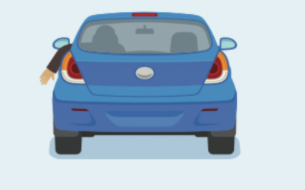
stop or slow down
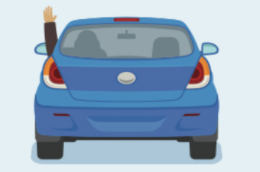
right turn
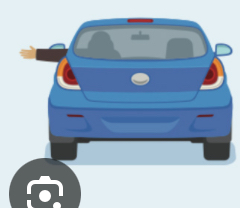
left turn
do you pass on solid yellow lines?
No
What is another name for Hand-to-Hand Steering?
A) One-hand steering
B) Oversteering
C) Push/Pull steering
D) Cross-over steering
C) push/pull steering
Why is Hand-to-Hand Steering considered safer during airbag deployment?
A) It allows faster turns
B) Your hands don’t cross the steering wheel
C) It uses only one hand
D) It turns the wheel automatically
B) Your hands don’t cross the steering wheel
When should Hand-Over-Hand Steering be used?
A) During high-speed driving
B) Only on the highway
C) When parking or turning at low speeds or need to recover from a skid
D) When driving straight
C) When parking or turning at low speeds or need to recover from a skid
When is it appropriate to use One-Hand Steering?
A) All the time
B) While texting
C) When driving in a straight line
D) When backing up or adjusting vehicle controls
D) When backing up or adjusting vehicle controls
What is the recommended hand position on the steering wheel for most situations?
A) 10 and 2 o’clock
B) 6 o’clock only
C) 12 o’clock only
D) 9 and 3 o’clock or 8 and 4 o’clock
D) 9 and 3 o clock OR 8 and 4 o clock
When should you start signaling before making a turn?
A) At least 100 feet before
B) At least 50 feet before
C) At least 25 feet before
D) After 150 feet before
A) At least 100 feet before
On a freeway, how many seconds before changing lanes should you signal?
A) 2 seconds
B) 3 seconds
C) 10 seconds
D) 5 seconds
D) 5 seconds
Why might you also need to use hand signals in addition to your vehicle’s signal lights?
A) Hand signals are faster
B) Your signal lights use too much battery
C) Bright sunlight can make signal lights hard to see
D) It's a law in all states
C) Bright sunlight can make signal lights hard to see
What could happen if you signal too early before turning after an intersection?
A) Drivers may speed past you
B) Other drivers may think you’re turning at the intersection and pull out in front
C) Your turn signal could break
D) Your car might stop unexpectedly
B) Other drivers think you’re turning at the intersection and pull out in front
On narrow mountain roads, when should you use your horn?
A) When someone is driving too slowly
B) When you cannot see at least 200 feet ahead
C) At every turn, regardless of visibility
D) Only if you're lost
B) when you cannot see at elast 200 feet ahead
Why should you avoid honking at pedestrians or cyclists unless it’s absolutely necessary?
A) It’s illegal
B) Your horn may sound louder outside and scare them
C) They must always yield anyway
D) They don’t have mirrors
B) Your horn may sound louder outside and scare them
When must you use your headlights?
A) Only when it's raining
B) Only at night
C) When it's too dark to see 1000 feet ahead
D) During the day if you're on the freeway
C) when its too dark to see 1000 see ahead
When do you need headlights on small country or mountain roads?
A) Aven during sunny days
B) Only during rain
C) Only at night
D) Only if signs tell you
A) Even during sunny days
When should you turn on your emergency flashers?
A) When you're driving slowly in a residential area
B) When you're listening to loud music
C) When stopped due to a breakdown or hazard ahead
D) When it’s raining
C) When stopped due to a breakdown or hazard ahead
What is a safe way to warn drivers behind you about a hazard ahead?
A) Honk repeatedly
B) Swerve between lanes
C) Flash your headlights rapidly
D) Lightly tap your brake pedal three or four times
D) lightly tap your break pedal three or four times
If your vehicle does NOT have emergency flashers, what should you use instead?
A) Turn on your headlights
B) Use your horn
C) Use your horn
D) Use your turn signals
D) use your turn signals
Where should you avoid stopping your vehicle if you experience trouble?
A) A rest area
B) A well-lit parking lot
C) Just over a hill or around a curve
D) The shoulder of the road
C) just over a hill or around a curve
If it is safe and you’re experiencing an emergency, lifting the hood of your vehicle helps to:
A) Cool the engine faster
B) Signal that you need help
C) Prevent your battery from draining
D) Alert police that you’re speeding
B) Signal that you need help
How far behind your vehicle should you place emergency flares or triangles (if available)?
A) 50-100 feet
B) 100-150 feet
C) 200-300 feet
D) Right next to your bumper
C) 200-300 feet
What does a single solid yellow line in the center of a two-way road mean?
A) You can pass if the road is clear
B) Passing is allowed on both sides
C)You must always turn
D) You may not cross over into oncoming traffic
D) You may not cross over into oncoming traffic
When is it acceptable to drive to the left of double solid yellow lines?
A) When you’re in a hurry, in a high occupancy vehicle (HOV) lane that has a designated entrance on the left, construction telling you to turn left
B) When making a U-turn or entering a driveway, in a high occupancy vehicle (HOV) lane that has a designated entrance on the left, construction telling you to turn left
C) When there’s no other traffic, in a high occupancy vehicle (HOV) lane that has a designated entrance on the left, construction telling you to turn left
D) When passing a slow vehicle, in a high occupancy vehicle (HOV) lane that has a designated entrance on the left, construction telling you to turn left
B) When making a U-turn or entering a driveway, in a high occupancy vehicle (HOV) lane that has a designated entrance on the left, construction telling you to turn left
What do two sets of double yellow lines spaced two or more feet apart represent?
A) A center turn lane
B) A passing zone
C) A traffic barrier
D) A bike lane
C) traffic barrier
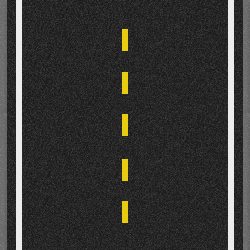
What does a broken yellow line next to your lane mean?
A) Do not pass at any time
B) Passing is allowed only if it is safe
C) You are on a one-way street
D) You must turn left
B) passing is allowed only if it is safe
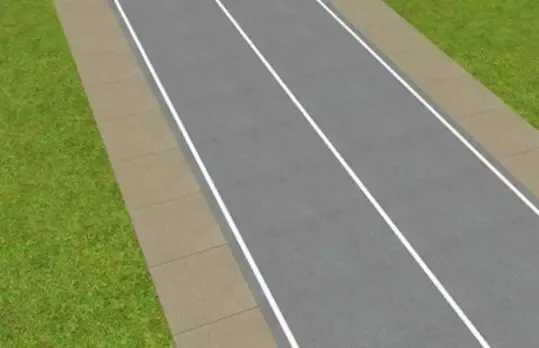
A single solid white line indicates:
A) Two-way traffic lanes
B) Passing is allowed
C) Lanes going in the same direction
D) A pedestrian crosswalk
C) lanes going in the same direction which you can change lanes
What do double solid white lines indicate?
A) Two-way traffic with passing allowed
B) A barrier between regular and preferential use lanes
C) A warning for upcoming speed changes
D) A yield area
B) a barrier between regular and preferential use lanes (such as a carpool lane)
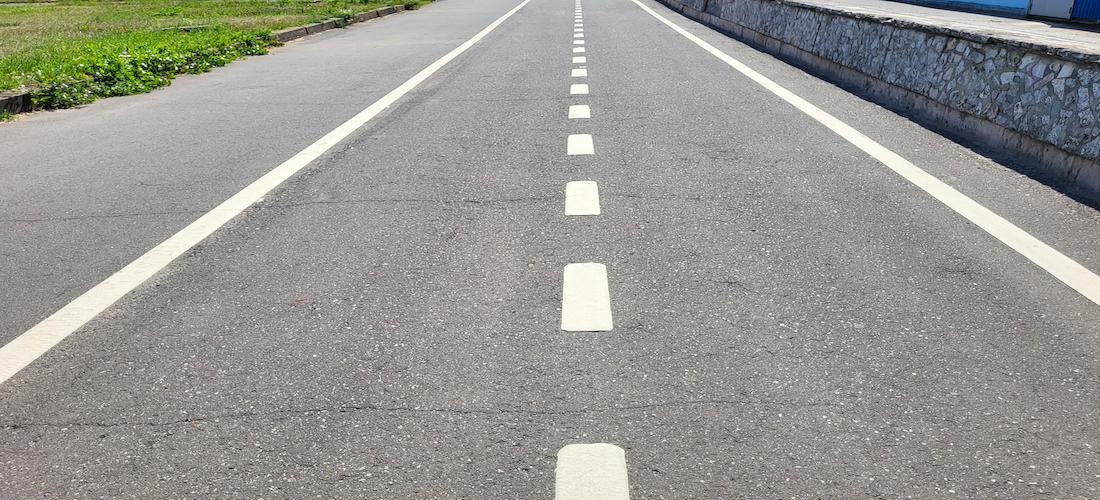
What do broken white lines separate?
A) Oncoming traffic
B) Pedestrian paths
C) a pedestrian crosswalk
D) Lanes going in the same direction
D) lanes going in the same direction
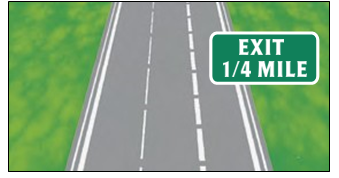
What do large broken lines at the end of a freeway or street lane indicate?
A) Merge or exit point
B) construction zone
C) No stopping zone
D) Emergency lane only
A) Merge or exit point

What does a yield line look like?
A) A row of solid circles
B) A zigzag pattern
C) A line of white triangles pointing toward approaching traffic
D) Two parallel dashed lines
C) A white line of white triangles pointing approaching traffic
What is the "Number 1 Lane"?
A) The far-right lane
B) The carpool lane
C) The left (or fast) lane
D) The center lane
C) the left (or fast) lane
Which lane should you generally use to exit traffic?
A) Number 1 Lane
B) Number 2 Lane
C) Right lane
D) Center lane
C) Right lane
What should you avoid when driving in traffic?
A) Weaving in and out of traffic
B) Driving in one lane the whole time
C) driving below the speed limit
D) Following signs
A) weaving in and out of traffic
What is the purpose of the passing lane (aka fast lane) on a multilane road?
A) For slower traffic to cruise comfortably
B) For emergency vehicles only
C) For turning left
D) For faster vehicles to pass others
D) For faster vehicles to pass others
What symbol marks an HOV (Carpool) lane?
A) A triangle
B) A diamond
C) A square
D) A star
B) a diamond
Which of the following can legally use an HOV lane? (Select all that apply)
A) A vehicle with only one person
B) A carpool with 2 or more people (as posted)
C) A motorcycle (unless otherwise posted)
D) A low-emission vehicle with a DMV-issued decal
B, C, D
When can you cross double solid lines to enter or exit an HOV lane?
A) Anytime traffic is slow
B) Only at designated entry/exit points
C) When passing a slower car
D) If no one is around
B) only at designated entry/exit points

What is the purpose of a center left turn lane?
A) To pass slower traffic
B) To make right turns
C) To park in heavy traffic
D) To prepare for and make a left turn or U-turn
D) to prepare for and make a left turn or U-turn
How far can you legally drive in a center left turn lane?
A) 50 feet
B) 100 feet
C) 200 feet
D) 300 feet
C) 200 feet
What should you do before turning from a center left turn lane?
A) Just turn quickly
B) Only use your mirrors
C) Signal and check your blind spot
D) Honk and move over
C) signal and check your blind spot
When are you required to use a turnout area or lane?
A) When one vehicle is behind you
B) When you're driving the speed limit
C) When 5 or more vehicles are behind you and passing is unsafe
D) Anytime you see a turnout lane
C) when 5 or more cars are behind you and passing is unsafe
What is a buffered bike lane?
A) A bike lane shared with pedestrians
B) A bike lane with extra space or markings separating it from traffic
C) A bike lane in the center of the road
D) A temporary bike lane
B) A bike lane with extra space or margins separating it from traffic
What is the main difference between a bike route and a bicycle boulevard?
A) A bike route is on highways, and a boulevard is on side streets
B) A bike route uses signs, while boulevards prioritize bike travel
C) A boulevard is for buses only
D) A bike route has no markings
B) A bike route uses signs, while boulevards prioritize bike travel
What is a separated bikeway (cycle track or protected bike lane)?
A) A bike lane physically separated from traffic
B) A bike lane with no markings
C) A shared path for pedestrians and bikes
D) A temporary bike lane in construction zones
A) A bike lane physically separated from traffic
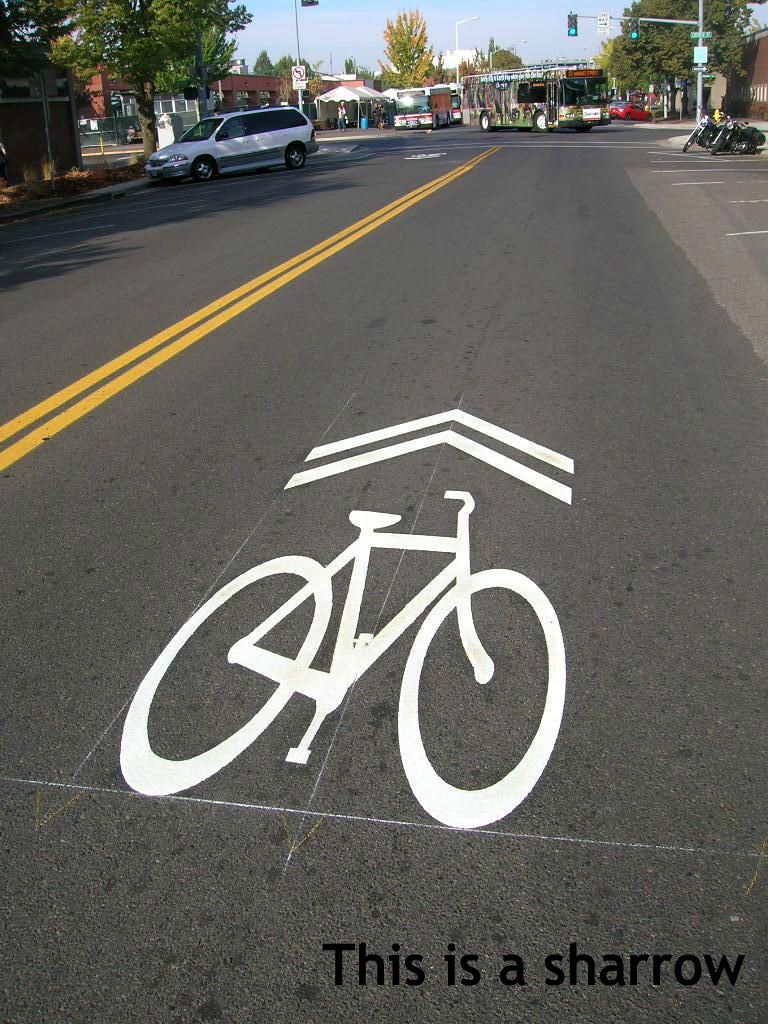
What do shared roadway bicycle markings (sharrows) indicate?
A) Only pedestrians can use the lane
B) Bicyclists must ride on the sidewalk
C) Drivers should expect and share the lane with bicyclists
D) Parking is not allowed
C) drivers should expect and share the lane with bicyclists
When is it legal to drive in a bicycle lane?
A) To pass slower traffic
B) To wait in line at an intersection
C) When making a turn within 200 feet
D) Anytime, if there are no bikes
C) when making a turn within 200 feet
How far in advance should you begin signaling before a right turn?
A) 50 feet
B) 100 feet
C) 200 feet
D) 25 feet
B) 100 feet
What is the correct position for making a left turn?
A) Close to the right edge of the road
B) In the far-right lane
C) Close to the center divider or in the left turn lane
D) Straddling the center of the intersection
C) close to the center divider or in the left turn lane
When making a U-turn, you should always use:
A) The far-left lane or center left turn lane
B) The center lane
C) The far-left lane
D) The far-right lane
A) the far-left lane or center left turn lane
In a residential district, you may make a U-turn if:
A) You are more than 50 feet from another vehicle
B) You are on a hill
C) No vehicles are approaching you within 200 feet
D) It is after 9 p.m.
C) No vehicles are approaching you within 200 feet (IT IS ILLEGAL TO MAKE U TURN ON ONE WAY)
When is it illegal to make a U-turn on a divided highway?
A) At a designated opening
B) If there are no cars coming
C)When you use your turn signal
D) If you cross a dividing section, curb, or strip of land
D) If you cross a dividing section, curb, or strip of land
In business districts, U-turns are only allowed:
A) In parking lots
B) At driveways and alleys
C) At intersections or where designated openings exist
D) Wherever there is space
C) At intersections or when designated openings exist
hen entering a highway, you should:
A) Stop at the end of the on-ramp and wait for a gap
B) Enter at or near the speed of traffic
C) Enter slowly to avoid startling other drivers
D) Merge all at once across several lanes
B) enter at or near the speed of traffic
What is the "three-second rule"?
A) How long you can drive in the shoulder
B) How long to wait at a stop sign
C) The safe space between your car and the one ahead
D) The maximum time to make a U-turn
C) the safe space between your car and the one ahead
How much space do you generally need to enter or cross traffic?
A) A quarter block in the city and half a block on the highway
B) Half a block on city streets and a full block on the highway
C) One block everywhere
D) Just enough to fit your car
B) Half a block on city streets and a full block on the highway
You should NOT pass when:
A) You're on a straight road
B) There are no cars coming
C) You're approaching a hill, curve, or within 100 feet of an intersection or railroad
D) The road is clear and wide
C) you’re approaching a hill, curve, or within 100 feet of an intersection or railroad
When is it okay to pass on the right?
A) Anytime you are in a hurry
B) When the driver ahead is turning right
C) On a one-way street or multi-lane road going your direction
D) When you’re on the shoulder
C) on a one way street or multi lane road going your direction
what is a 5-side sign?
this sign warms you of specific road conditions and dangers ahead
what is a white rectangular sign?
signs telling you to obey
At a green traffic signal light, who has the right-of-way?
A. Only the cars
B. You, always
C. Pedestrians crossing the street
D. Bicycles only
C. Pedestrians crossing the street
When turning left, who should you yield to?
A. No one
B. Only pedestrians
C. Only cars behind you
D. Oncoming cars, motorcycles, bikes, and pedestrians
D. oncoming cars, motorcycles, bikes, and pedestrians
At an intersection with STOP signs on all corners, what do you do first?
A. Look both ways and go
B. Stop, then go when it’s your turn
C. Go as soon as the person across from you goes
D. Only stop if someone is coming
B. Stop, then go when it is ur turn
If you and another vehicle arrive at the same time at an intersection without signs, who goes first?
A. The person on your right
B. The biggest vehicle
C. The person on your left
D. Whoever honks first
A. the person on your right
What should you do as you approach a roundabout?
A. Speed up to beat traffic
B. Stop completely
C. Slow down and prepare to yield
D. Turn on your hazard lights
C. slow down and prepare to yield
On a steep, narrow mountain road, if two vehicles meet and cannot pass, who must yield?
A. The vehicle going uphill
B. The larger vehicle
C. The faster vehicle
D. The vehicle going downhill
D. The vehicle going downhill (also the car going downhill must back a spot so the car coming up can pass since the car going up has the right of way)
What should you do when a bus, streetcar, or trolley is picking up or dropping off passengers and there is no safety zone?
A. Pass it quickly on the left
B. Honk to let people know you’re coming
C. Stop behind the nearest door and wait until passengers are safe
D. Drive slowly around the bus
C. stop behind the nearest door and wait until passengers are safe
How are safety zones marked?
A. Solid yellow lines
B. Reflective tape
C. Dotted white lines or raised buttons/markers
D. Red curbs
C. dotted white lines or raised buttons/markers
If a bus, streetcar, or trolley is stopped at a safety zone or traffic light, how fast can you pass it?
A. Up to 25 mph
B. 15 mph
C. As fast as how traffic goes
D. No faster than 10 mph
D. no faster than 10 mph
4. What should you do when you see an emergency vehicle with sirens and flashing red lights?
A. Speed up to get out of the way
B. Stop immediately in the lane you're in
C. Move to the right edge of the road and stop until it passes
D. Pull over to the left side and stop
C. move to the right edge of the road and stop until it passes
What do you do if you see an emergency vehicle while you're in an intersection?
A. Continue through the intersection, then move to the right and stop
B. Speed through as fast as you can
C. Stop in the middle of the intersection
D. Make a U-turn
A. Continue through the intersection, then move to the right and stop
Is it okay to follow a fire truck with flashing lights if you keep a safe distance?
A. Yes, as long as you're not in a hurry
B. No, it is illegal to follow within 300 feet
C. Yes, but only if it's daytime
D. Yes, if you turn off your high beams
B. No, it is illegal to follow within 300 feet
What is California’s "Basic Speed Law"?
A. You must follow the posted speed limit no matter what
B. You can drive as fast as you want if traffic is light
C. Never drive faster than is safe for the road conditions
D. Always drive 10 mph below the speed limit
C. Never drive faster than is safe for the road conditions
What is the maximum speed limit on a two-lane undivided highway (unless posted otherwise)?
A. 55 mph
B. 60 mph
C. 65 mph
D. 50 mph
A. 55 mph
When towing a trailer, which lane must you drive in?
A. The far-right lane or a lane marked for slower vehicles
B. The fast lane
C. Any lane you want
D. The center lane
A. The far-right lane or a lane marked for slower vehicles
What is the speed limit when driving within 500–1000 feet of a school with children present (unless posted otherwise)?
A. 35 mph
B. 25 mph
C. 20 mph
D. 40 mph
B. 20 mph
What makes an intersection "blind"?
A. You are within 100 feet and cannot see 100 feet in both directions
B. It is not near a school
C. When they are all 4 stop signs at each side
D. The intersection has stop signs
A. You are within 100 feet and cannot see 100 feet in both directions
What vehicles must always stop before crossing railroad tracks?
A. Police cars
B. Trucks with no cargo
C. Buses, school buses, and trucks carrying hazardous materials
D. All motorcycles
C. Buses, school buses, and trucks carrying hazardous materials
What is the speed limit in any alley?
A. 20 mph
B. 10 mph
C. 25 mph
D. 15 mph
D. 15 mph (applies to blind intersections and railroad tracks)
What should you do when you see a funeral procession?
A. Honk and drive around it
B. Turn on your hazard lights and join it
C. Yield and do not interrupt the procession
D. Speed up to pass the lead vehicle
C. yield and do not interrupt the procession (they always have the right of way)
When it is raining at night, what type of headlights should you use?
A. High-beam headlights
B. Low-beam headlights
C. Only your parking lights
D. Both high and low beams at the same time
B. Low-beam headlights
What should you do if your vehicle starts to hydroplane (like water firing at sides when crossing watery road)?
A. Speed up to regain control
B. Turn the steering wheel sharply to correct your direction
C. Use the brakes immediately
D. Slow down gradually without using the brakes
D. Slow down gradually without using the brakes
What should you do at the first sign of rain, drizzle, or snow?
A. Speed up to avoid the rain
B. Turn on your windshield wipers, high-beam headlights, and defroster
C. Slow down and turn on your windshield wipers, low-beam headlights, and defroster
D. Continue driving at your regular speed
C. Slow down and turn on your windshield wipers, low-beam headlights, and defroster
When driving in high winds, why should you avoid using cruise control?
A. Cruise control makes it easier to react to strong gusts of wind
B. It gives you better control of the accelerator during gusts
C. Cruise control helps you maintain speed
D. It reduces the chances of hydroplaning
B. It gives you better control of the accelerator during gusts
What is the best headlight setting when driving in heavy fog or smoke?
A. High-beam headlights
B. Low-beam headlights
C. Parking or fog lights
D. No headlights
B. low beam-headlights

What is one way to reduce traffic congestion?
A. Tailgate the vehicle in front of you
B. Weave in and out of freeway lanes
C. Avoid unnecessary lane changes
D. Use your cell phone while driving
C. Avoid unnecessary lane changes
What type of child passenger restraint system should be used for a child under 2 years old?
A. A rear-facing child passenger restraint system
B. A forward-facing car seat
C. A booster seat
D. A regular seat belt
A. A rear-facing child passenger restraint system
What should you do if your vehicle starts to skid on a slippery surface?
A. Slam on the brakes to stop the vehicle
B. Turn the steering wheel away from the direction of the skid
C. Slowly remove your foot from the gas pedal and turn the steering wheel in the direction of the skid
D. Speed up to regain traction
C. Slowly remove your foot from the gas pedal and turn the steering wheel in the direction of the skid